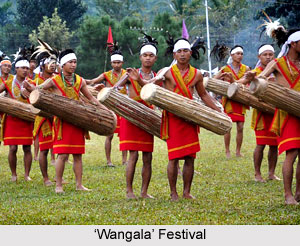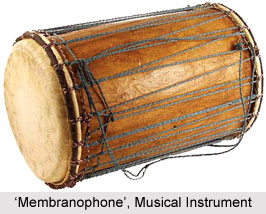 Culture of West Garo Hills District is inclusive of the individual tastes and traditions of the various local tribes who reside in the region of West Garo Hills. They follow the pattern of a matrilineal society which consists of the children, husband and his wife. The youngest daughter of the family occupies a significant social status and is referred to as `Nokna` and her husband is termed `Nokrom`. She is entitled to a lion`s share in the property of her mother and the remaining portion of the property is shared by her other sisters. The utensils utilized by the regional people of West Garo Hills District are earthenware containers, cooking pots, mortar and pestle and some others. Different kinds of bamboo baskets are popular amongst the local people of this region.
Culture of West Garo Hills District is inclusive of the individual tastes and traditions of the various local tribes who reside in the region of West Garo Hills. They follow the pattern of a matrilineal society which consists of the children, husband and his wife. The youngest daughter of the family occupies a significant social status and is referred to as `Nokna` and her husband is termed `Nokrom`. She is entitled to a lion`s share in the property of her mother and the remaining portion of the property is shared by her other sisters. The utensils utilized by the regional people of West Garo Hills District are earthenware containers, cooking pots, mortar and pestle and some others. Different kinds of bamboo baskets are popular amongst the local people of this region.
Wooden stools, bamboo floors, cane or bamboo chairs are some of the rare pieces of furniture which are favoured by the local inhabitants of West Garo Hills District. Most of the items of furniture used by these people are home-made. They are fond of weapons and are known to use two edged swords which are termed as `Milam`, and composed of a single piece of iron. Other commonly used weapons include daggers, bows, spears, arrows, axes and others.
Rice forms the staple diet of the people of West Garo Hills. Tapioca, millets, maize, etc are the other food grains which are consumed by them. Non-vegetarian food items are also relished by the people of this region. Dense forests and the fields of Jhum offer abundant sources of vegetables like bamboo shoots which appeal to the taste-buds of the Garo people. Dry stems of plantains are burned in order to derive potash which is used in curries. These curries are locally termed as `Kalchi` or `Katchi`. Liquor is also savoured by the local residents.
 Cotton represents the main textile of this part of the country since Garo`s principle cash crop is cotton. Local men are clad in a piece of woven cotton cloth which measures about six inches id width and six feet in length. Some of their cotton garments are embellished with a series of conch shells or white beads. Sometimes, the men of West Garo Hills can be noticed wearing black coloured vests which possess a lining near its ends. Body cloths are used by the local womenfolk who are accompanied by a skirt known as `Dakmanda`. A colourful headband completes the attire of a typical lady belonging to the West Garo Hills District. Jewelleries are cherished by these people and worn by men as well as women. Ornaments like `Natapsi` which implies a string of beads which are worn in the upper portion of the ears, `Ripok` which are necklaces composed of silver or brass, `Jaksan` which means bangles manufactured from various substances, `Pilne` which is a head jewellery which is used by the local ladies of Garo Hills during dances and `Jaksil` which is a elbow ring that is worn by the rich men-folk during Gana ceremonies.
Cotton represents the main textile of this part of the country since Garo`s principle cash crop is cotton. Local men are clad in a piece of woven cotton cloth which measures about six inches id width and six feet in length. Some of their cotton garments are embellished with a series of conch shells or white beads. Sometimes, the men of West Garo Hills can be noticed wearing black coloured vests which possess a lining near its ends. Body cloths are used by the local womenfolk who are accompanied by a skirt known as `Dakmanda`. A colourful headband completes the attire of a typical lady belonging to the West Garo Hills District. Jewelleries are cherished by these people and worn by men as well as women. Ornaments like `Natapsi` which implies a string of beads which are worn in the upper portion of the ears, `Ripok` which are necklaces composed of silver or brass, `Jaksan` which means bangles manufactured from various substances, `Pilne` which is a head jewellery which is used by the local ladies of Garo Hills during dances and `Jaksil` which is a elbow ring that is worn by the rich men-folk during Gana ceremonies.
As per the traditions of the West Garo Hills District, girls propose marriage to the boys. The laws of `A`Kim` and `Exogamy` govern the laws of marriage in this region. No marriages can be legalised if the bride and groom belong to similar castes. In case of the death of a woman, her sister should marry her husband. If a man dies, his wife has to marry one of his nephews. However, is such a match cannot be found, the marriage is called off and nullified and the woman or man is given the right to marry a person of their choice.
The Garos believe in the existence of a Supreme God who is revered as `Dakgipa Rugipa Stugipa Pantugipa` and also `Tatora Rabuga Stura Pantura` which implies the `creator`. Monotheism occupies a prominent place in the religion of the people of West Garo Hills. Christianity, Hinduism, Pantheism and Buddhism are some of the religions practised by the regional inhabitants of West Garo Hills District. They worship numerous Gods like `Susince` or Goddess of Riches, `Choradubi` or the protector or crops, `Saljong` or God of Fertility and `Goers` or God of strength. Such Gods are thought to protect them from all kinds of disasters, ill fates, and their blessings are invoked during social occasions like marriages, births, etc.
Regular festivals are celebrated with great pomp by the people of West Garo Hills District. `Wangala` is an important local festival which involves the ritual of thanksgiving to Gods for good harvest. It is carried out in the month of October and sometimes November. Drums and gongs are beaten while horns are blown to mark this special festive occasion. Dances like `Chambil mpa`, `Gaewang roa`, `Ajima roa`, `Napsepgrika` and many others are popular in this portion of India. Musical instruments of these people comprise aerophone, idiophones, membranophone, chordophone and others.






